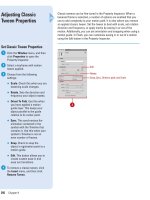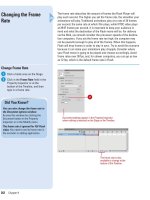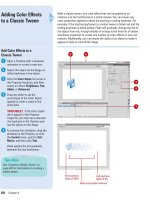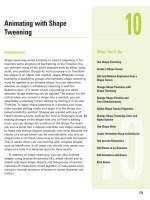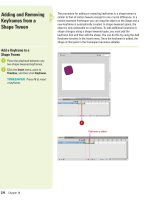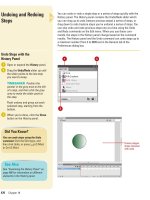Tài liệu Thiết kế flash với flash cs5 part 39 pdf
Bạn đang xem bản rút gọn của tài liệu. Xem và tải ngay bản đầy đủ của tài liệu tại đây (537.93 KB, 6 trang )
ptg
256
Chapter 9
Classic tweens can be fine-tuned in the Property Inspector. When a
tweened frame is selected, a number of options are enabled that you
use to add complexity to your motion path. It is also where you remove
an applied classic tween. Set the tween to deal with scale, set rotation
direction and frequency, or apply inertia by easing in or out of the
motion. Additionally, you can set orientation and snapping when using a
motion guide. In Flash, you can customize easing in or out of a motion
using the Edit button in the Property Inspector.
Adjusting Classic
Tween Properties
Set Classic Tween Properties
Click the Window menu, and then
click Properties to open the
Property Inspector.
Select a keyframe with motion
tween applied.
Choose from the following
settings:
◆
Scale. Check this when you are
tweening scale changes.
◆
Rotate. Sets the direction and
frequency your object rotates.
◆
Orient To Path. Use this when
you have applied a motion
guide layer. This keeps your
object parallel to the guide
relative to its center point.
◆
Sync. This synchronizes the
animation contained in the
symbol with the Timeline that
contains it. Use this when your
symbol's Timeline is not an
even number of frames.
◆
Snap. Check to snap the
object's registration point to a
motion guide.
◆
Edit. This button allows you to
create custom ease in and
ease out transitions.
To remove a classic tween, click
the Insert menu, and then click
Remove Tween.
4
3
2
1
Snap, Sync, Orient to path, and Scale
Rotate
Edit
3
From the Library of Wow! eBook
ptg
Chapter 9 Animating with Classic Tweening
257
Set Ease Properties in a
Classic Tween
Click the Window menu, and then
click Properties to open the
Property Inspector.
Select a keyframe with motion
tween applied.
Click the Ease field, and then
select the setting to set the speed
at which your object eases in or
out of its motion.
A positive value eases in, a
negative value eases out. A zero
value evenly distributes motion
across each frame.
3
2
1
No Easing
Ease Out
Ease In
Motion is evenly distributed
across frames.
Most of the motion is applied to the beginning frames
so the object appears to slow down as it stops.
Most of the motion is applied
to the end frames so the object
appears to slowly accelerate.
3
From the Library of Wow! eBook
ptg
258
Chapter 9
After you fine-tune a motion tween, you can copy and paste the frames,
tween, and symbol information to another object. When you paste a
motion tween, you can also specify the motion tween properties you
want to apply, such as X and Y position, horizontal and vertical scale,
color, filters, and blend. You can also override target scale, rotation,
and skew properties. If you want to use a motion tween as ActionScript
3.0 in the Actions panel or other code-specific location, you can use
the Copy As ActionScript command.
Copying and Pasting
a Tween
Copy and Paste a Motion Tween
Select the frames in the Timeline
with the motion tween you want to
copy. The frames you select need
to be on the same layer. However,
the selection can span a tween,
empty frames, or two or more
tweens.
Click the Edit menu, point to
Timeline, and then click Copy
Motion.
Select the symbol instance to
receive the copied motion tween.
Click the Edit menu, point to
Timeline, and then click Paste
Motion.
The frames, tween, and symbol
information are inserted to match
the original copied tween.
4
3
2
1
2
1
3
Motion pasted to instance
From the Library of Wow! eBook
ptg
Chapter 9 Animating with Classic Tweening
259
Paste Motion Tween Properties
Select the frames in the Timeline
with the motion tween you want to
copy.
Click the Edit menu, point to
Timeline, and then click Copy
Motion.
Select the symbol instance to
receive the copied motion tween.
Click the Edit menu, point to
Timeline, and then click Paste
Motion Special.
Choose from the following
settings:
◆
X or Y Position. Pastes how
much to move in the X
(horizontal) and Y (vertical)
direction.
◆
Horizontal or Vertical Scale.
Pastes the ratio between the
current and the natural size in
the horizontal (X) or vertical (Y)
direction.
◆
Rotation And Skew. Pastes the
rotation of the object.
◆
Color. Pastes the color values
of the object.
◆
Filters. Pastes the filter
properties of the object.
◆
Blend Mode. Pastes the blend
properties of the object.
◆
Override Target Scale or
Rotation and Skew Properties.
Select to override the existing
scale, or rotation and skew
properties of the object. Clear
to paste the properties relative
to the target object.
Click OK.
6
5
4
3
2
1
6
5
Copying Motion As ActionScript 3.0
In addition to copying motion tweens in the Timeline, you can also copy
motion tweens to the Actions panel or use them as ActionScripts. To
accomplish this task, you use the Copy Motion As ActionScript com-
mand. This command copies the properties that define a motion tween
in the Timeline as ActionScript 3.0. These properties include Position,
Scale, Skew, Rotation, Transformation Point, Color, Blend Mode,
Orientation To Path, Cache As Bitmap Setting, Frame Labels, Motion
Guides, Custom Easing, and Filters. After you copy the properties, you
can apply them to another symbol in the Actions panel or in the source
files for the Flash document that uses ActionScript 3.0. To copy a
motion tween as ActionScript 3.0, select the frames in the Timeline with
the motion tween you want to copy, click the Edit menu, point to
Timeline, click Copy Motion As ActionScript 3.0, type the name of the
instance to attach the motion tween to, and then click OK. Flash gener-
ates ActionScript for the specific instance name. The code appears on
the Clipboard for use in the Actions Panel or other place.
For Your Information
From the Library of Wow! eBook
ptg
260
Chapter 9
Tweens in Flash are editable after they have been created. You can
continue to change their properties and position in the Timeline, and
Flash redraws the tweened frames. To change the length of a motion or
shape tween (that is, the time it takes to complete the tween), you can
add or remove frames in the framespan. Essentially you are adjusting
the amount of frames Flash uses in its calculation of the tween. Adding
frames means it takes longer for the transformation to happen, while
deleting frames shortens the time.
Changing the Length
of a Tween
Add Frames to a Tween
Click anywhere except the last
keyframe on a motion or shape
tweened framespan to place the
playhead.
◆
To add multiple frames, select
multiple frames in the Timeline.
Click the Insert menu, point to
Timeline, and then click Frame.
TIMESAVER
Press F5 to add
frames.
2
1
1
Frame is added to tween span.
Duration of other tweens
is maintained.
From the Library of Wow! eBook



